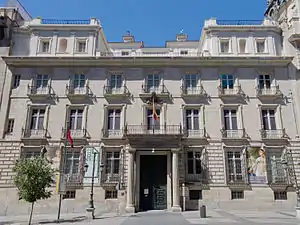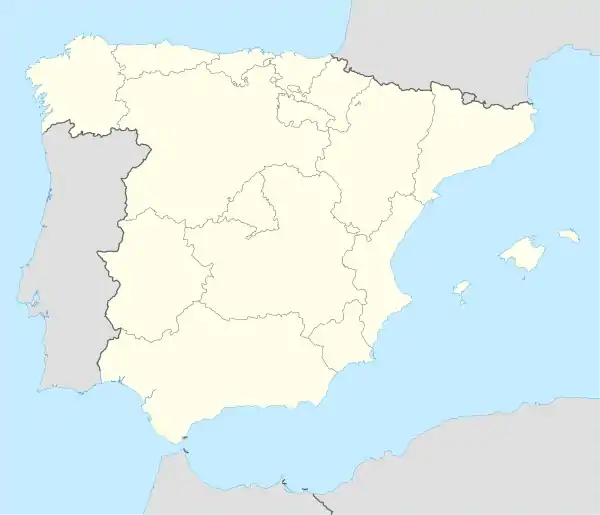Real Academia de Bellas Artes de San Fernando
The Real Academia de Bellas Artes de San Fernando (Royal Academy of Fine Arts of San Fernando), located on the Calle de Alcalá in the heart of Madrid, currently functions as a museum and gallery.
 | |
| Type | Public |
|---|---|
| Established | 1752 |
| Location | , Spain |
| Website | www |
| Real Academia de Bellas Artes de San Fernando | |
|---|---|
| Native name Spanish: Real Academia de Bellas Artes de San Fernando | |
 | |
| Location | Madrid, Spain |
| Official name | Real Academia de Bellas Artes de San Fernando |
| Type | Non-movable |
| Criteria | Monument |
| Designated | 1971 |
| Reference no. | RI-51-0003855 |
 Location of Real Academia de Bellas Artes de San Fernando in Spain | |
The academy was established by royal decree in 1752. About twenty years later, the enlightened monarch Charles III purchased a palace in Madrid as the academy's new home. The building had been designed by José Benito de Churriguera for the Goyeneche family. The king commissioned Diego de Villanueva to convert the building for academic use, employing a neoclassical style[1] in place of Churriguera's baroque design.
Doubling as a museum and gallery, today it houses a fine art collection of paintings from the 15th to 20th centuries: Arcimboldo, Giovanni Bellini, Antonio Allegri da Correggio, Guido Reni, Rubens, Giovanni Battista Beinaschi, Zurbarán, Murillo, Fragonard, Goya, Giuseppe Pirovani (one rare Portrait of George Washington), Juan Gris, Pablo Serrano, Lorenzo Quiros, among others. The academy is also the headquarters of the Madrid Academy of Art.
The first graduate of the academy was Bárbara María Hueva.[2]
Francisco Goya was once one of the academy's directors, and its alumni include Felip Pedrell, Pablo Picasso, Kiko Argüello, Remedios Varo, Salvador Dalí, Antonio López García, Juan Luna, Oscar de la Renta, and Fernando Botero.[3][4]
References
- (in Spanish) La institución Official website. Retrieved 26 May 2013.
- Shearjashub Spooner (1880). Anecdotes of Painters, Engravers, Sculptors and Architects, and Curiosities of Art. A.W. Lovering. pp. 210–211.
- Gomadrid.com
- Karaart.com
External links
 Media related to Real Academia de Bellas Artes de San Fernando at Wikimedia Commons
Media related to Real Academia de Bellas Artes de San Fernando at Wikimedia Commons- Real Academia de Bellas Artes de San Fernando
- Android and iOS Official mobile app